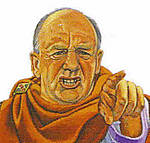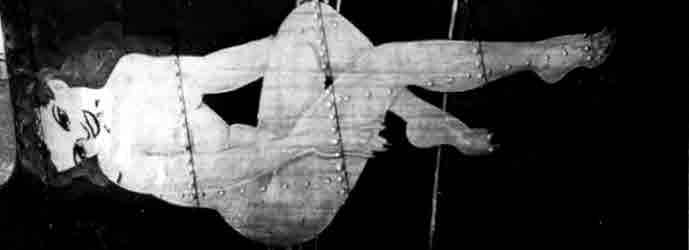Tom:
Your turret work is fantastic. I really love the scratch building you did on the ball turret. The interior work you did give me some pointers on the large task I have doing a good ball turret interior for my B-17F. In my case the plan is to have the turret appear off-center with the access door open. So, the interior work you did give me some great pointers on approaches to detailing the interior. It is, after all, the same target for all intents and purposes.
Needless to say, I'll keep following.
Brian
Hosted by Rowan Baylis
B-24H Libra 1/48 Scale
Posted: Saturday, April 08, 2017 - 09:07 PM UTC
thathaway3

Joined: September 10, 2004
KitMaker: 1,610 posts
AeroScale: 85 posts

Posted: Saturday, April 08, 2017 - 11:06 PM UTC
Thanks! The most noticeable difference between the ball turrets in the B-24 and B-17 that I observed was the presence of fixed ammo boxes and loading chutes on either side of the drive mechanism to feed ammo into the turret.
Every PHOTO I found of a B-24 interior did not include that feature, and the only interior shot showing that arrangement was of a B-17.
That said, it does seem strange that one would have it and the other not, as it's the same Sperry turret and you gotta feed ammo to it.
I did find a line drawing labeled "Sperry Ball Turret" which does show the cans and chutes and mounting system so I'm thinking a may add them.
If anybody knows for sure that the B-24 used the same arrangement that would be great to know.
As far as what type of glue to use on the clear plastic, I've found regular styrene glue is the best. If you use C/A super glue the fumes will tend to cloud the plastic. The Koster material seems to bond just find with regular cement.
One tip that seems to help apply the glue is that I take a flat sheet of plastic which is my normal work/cutting surface, and spread out the glue on that in the approximate shape of the glass surface that I'm planning to glue. I then rub the surface to be glued onto the glue which is now lying flat on the surface and apply it that way to the edge. That way it doesn't "run" like it tends to if you try to apply it directly from the bottle or tube.
One other trick I've found is that after the two halves are glued, if there's a seam that I don't like, I'll take a piece of .010" styrene rod, and soak it in Plastruct Plastic Weld to get it soft and then bend it around the seam, applying additional liquid weld as I go to fill in the gap.
The liquid plastic weld seems to not have the same sort of action as regular cement in that it will soften the plastic rod pretty well, but doesn't seem to affect the other flat surface nearly as much as regular glue would, and it's a lot easier to clean it up after you've applied.
After it's dried it paints and sands away with very little gap. This of course works MUCH better where the seam is between two PAINTED halves.
Where you gluing two CLEAR halves together, you just have to be VERY careful when you cut the two surfaces to be joined to have a straight even seam, and apply the glue in the same way and hope for the best!
But if you've never used this technique before, I'd practice on something that isn't critical first to get some experience with it. I've use it a lot on ship models to fill in the gaps between decks and vertical surfaces like hull and bulkheads.
Every PHOTO I found of a B-24 interior did not include that feature, and the only interior shot showing that arrangement was of a B-17.
That said, it does seem strange that one would have it and the other not, as it's the same Sperry turret and you gotta feed ammo to it.
I did find a line drawing labeled "Sperry Ball Turret" which does show the cans and chutes and mounting system so I'm thinking a may add them.
If anybody knows for sure that the B-24 used the same arrangement that would be great to know.
As far as what type of glue to use on the clear plastic, I've found regular styrene glue is the best. If you use C/A super glue the fumes will tend to cloud the plastic. The Koster material seems to bond just find with regular cement.
One tip that seems to help apply the glue is that I take a flat sheet of plastic which is my normal work/cutting surface, and spread out the glue on that in the approximate shape of the glass surface that I'm planning to glue. I then rub the surface to be glued onto the glue which is now lying flat on the surface and apply it that way to the edge. That way it doesn't "run" like it tends to if you try to apply it directly from the bottle or tube.
One other trick I've found is that after the two halves are glued, if there's a seam that I don't like, I'll take a piece of .010" styrene rod, and soak it in Plastruct Plastic Weld to get it soft and then bend it around the seam, applying additional liquid weld as I go to fill in the gap.
The liquid plastic weld seems to not have the same sort of action as regular cement in that it will soften the plastic rod pretty well, but doesn't seem to affect the other flat surface nearly as much as regular glue would, and it's a lot easier to clean it up after you've applied.
After it's dried it paints and sands away with very little gap. This of course works MUCH better where the seam is between two PAINTED halves.
Where you gluing two CLEAR halves together, you just have to be VERY careful when you cut the two surfaces to be joined to have a straight even seam, and apply the glue in the same way and hope for the best!
But if you've never used this technique before, I'd practice on something that isn't critical first to get some experience with it. I've use it a lot on ship models to fill in the gaps between decks and vertical surfaces like hull and bulkheads.
Posted: Sunday, April 09, 2017 - 02:44 AM UTC
Tom:
Karl Hauffe produced some diagrams and technical data while commenting on my B-17F build that pretty much destroys the idea that any B-17 carried those ammo cans in the framework structure above the ball itself. There may be one or two photos showing operational B-24's with the setup, but it doesn't really make sense. The reason I say this is that when you look at the data and drawings Karl produced it shows that there was ample space within the ball itself to load the ammo. There were in fact two ammo storage areas, one above each gun, where the ammo rested and fed into the chambers. Check out my build or Google "Sperry ball turret" and you should see evidence supporting Karl's argument.
To put another way, the cans above the balls are a figment of the imagination of "warbird" restorers who don't know what they're doing. So, I think you can leave the above-the-ball framework without the ammo cans.
Karl Hauffe produced some diagrams and technical data while commenting on my B-17F build that pretty much destroys the idea that any B-17 carried those ammo cans in the framework structure above the ball itself. There may be one or two photos showing operational B-24's with the setup, but it doesn't really make sense. The reason I say this is that when you look at the data and drawings Karl produced it shows that there was ample space within the ball itself to load the ammo. There were in fact two ammo storage areas, one above each gun, where the ammo rested and fed into the chambers. Check out my build or Google "Sperry ball turret" and you should see evidence supporting Karl's argument.
To put another way, the cans above the balls are a figment of the imagination of "warbird" restorers who don't know what they're doing. So, I think you can leave the above-the-ball framework without the ammo cans.
KPHB17FE

Joined: January 12, 2015
KitMaker: 292 posts
AeroScale: 292 posts

Posted: Sunday, April 09, 2017 - 06:47 AM UTC
First of all, AWESOME job on the ball especially the support structure. Truly incredible work! How the heck do you make so many little details and make them look right? You are a master scratch builder in my book  . As for the external ammo cans on the ball, SOME very LATE B-24's had them. I have seen one factory photo of them installed. I don't have my references with me but I think it was late enough that they didn't make it into the combat zones. Must have had a bunch of them left over after the war and somebody packed them away Then when warbirds first started being restored they were available and used. It was a ball turret, nobody worried about details. Use your ball as is, it is superb...
. As for the external ammo cans on the ball, SOME very LATE B-24's had them. I have seen one factory photo of them installed. I don't have my references with me but I think it was late enough that they didn't make it into the combat zones. Must have had a bunch of them left over after the war and somebody packed them away Then when warbirds first started being restored they were available and used. It was a ball turret, nobody worried about details. Use your ball as is, it is superb...
 . As for the external ammo cans on the ball, SOME very LATE B-24's had them. I have seen one factory photo of them installed. I don't have my references with me but I think it was late enough that they didn't make it into the combat zones. Must have had a bunch of them left over after the war and somebody packed them away Then when warbirds first started being restored they were available and used. It was a ball turret, nobody worried about details. Use your ball as is, it is superb...
. As for the external ammo cans on the ball, SOME very LATE B-24's had them. I have seen one factory photo of them installed. I don't have my references with me but I think it was late enough that they didn't make it into the combat zones. Must have had a bunch of them left over after the war and somebody packed them away Then when warbirds first started being restored they were available and used. It was a ball turret, nobody worried about details. Use your ball as is, it is superb...Posted: Sunday, April 09, 2017 - 07:16 AM UTC
Hi Tom,
Neat. I'll be watching.
Koster? Glad they are still around.

Neat. I'll be watching.
Koster? Glad they are still around.

Posted: Sunday, April 09, 2017 - 07:21 AM UTC
Your turret detailing is amazing and excellent.
thathaway3

Joined: September 10, 2004
KitMaker: 1,610 posts
AeroScale: 85 posts

Posted: Sunday, April 09, 2017 - 07:38 PM UTC
Quoted Text
As for the external ammo cans on the ball, SOME very LATE B-24's had them. I have seen one factory photo of them installed. I don't have my references with me but I think it was late enough that they didn't make it into the combat zones. Must have had a bunch of them left over after the war and somebody packed them away Then when warbirds first started being restored they were available and used.
Thanks so much for your notes. I also found a few photos showing the installation of this system, but they appear to be modern photos (i.e. likely restored warbirds as you stated), and what you're saying about a late innovation with not too many making it into production but being left over makes a LOT of sense. So I'll ignore them for this build.
Thanks again for your kind comments. I have to admit that I spent 30 years working in Product Development for Ford Motor Company, much of it as a design engineer, so that helps a lot in figuring out how to "make" something to perform a certain function. And a whole lot easier when I have a picture to work from! All those years of reading 2-D drawings!!!
pnance26

Joined: January 22, 2016
KitMaker: 766 posts
AeroScale: 103 posts

Posted: Sunday, April 09, 2017 - 08:35 PM UTC
What great looking work! The detail is amazing!
Will keep watching... if the turret work goes to the entire airframe, this will be something else... and the Liberator is one of my favorite aircraft along with the Mitchell!
Will keep watching... if the turret work goes to the entire airframe, this will be something else... and the Liberator is one of my favorite aircraft along with the Mitchell!
thathaway3

Joined: September 10, 2004
KitMaker: 1,610 posts
AeroScale: 85 posts

Posted: Monday, April 17, 2017 - 08:25 PM UTC
OK, time for some questions.
First of all, what color would be the most appropriate for the interior of a Ford built B-24H, which from what I can gather would have been built prior to April 1944 when Willow Run began producing B-24J's.
And second, what is the preferred sequence for painting and assembling. I'm thinking right now that I'll paint the interior, and leave the outside unpainted. Next I'll do all of the interior detailing.
So at that point, do I close up the fuselage mask over any installed glass (that which needs to be put in from the INSIDE) as well as openings, and then paint the outside?
What about the nose and tail turrets which seem to be BEST installed into a half of the fuselage and then held in place by putting the two fuselage halves together. Do you assemble, paint and then pry the halves apart slightly to insert the turrets?
Any advice from someone who's had success (or even failure)

First of all, what color would be the most appropriate for the interior of a Ford built B-24H, which from what I can gather would have been built prior to April 1944 when Willow Run began producing B-24J's.
And second, what is the preferred sequence for painting and assembling. I'm thinking right now that I'll paint the interior, and leave the outside unpainted. Next I'll do all of the interior detailing.
So at that point, do I close up the fuselage mask over any installed glass (that which needs to be put in from the INSIDE) as well as openings, and then paint the outside?
What about the nose and tail turrets which seem to be BEST installed into a half of the fuselage and then held in place by putting the two fuselage halves together. Do you assemble, paint and then pry the halves apart slightly to insert the turrets?
Any advice from someone who's had success (or even failure)

thathaway3

Joined: September 10, 2004
KitMaker: 1,610 posts
AeroScale: 85 posts

Posted: Sunday, April 23, 2017 - 02:15 AM UTC
I finally finished the Sperry Ball Turret. After a test install of my original scratch build, I realized that the shaft mechanism was too long and allowed for too much drop from the stowed to deployed or lowered positions, so I had to rebuild the shaft to correct it. Much better now.
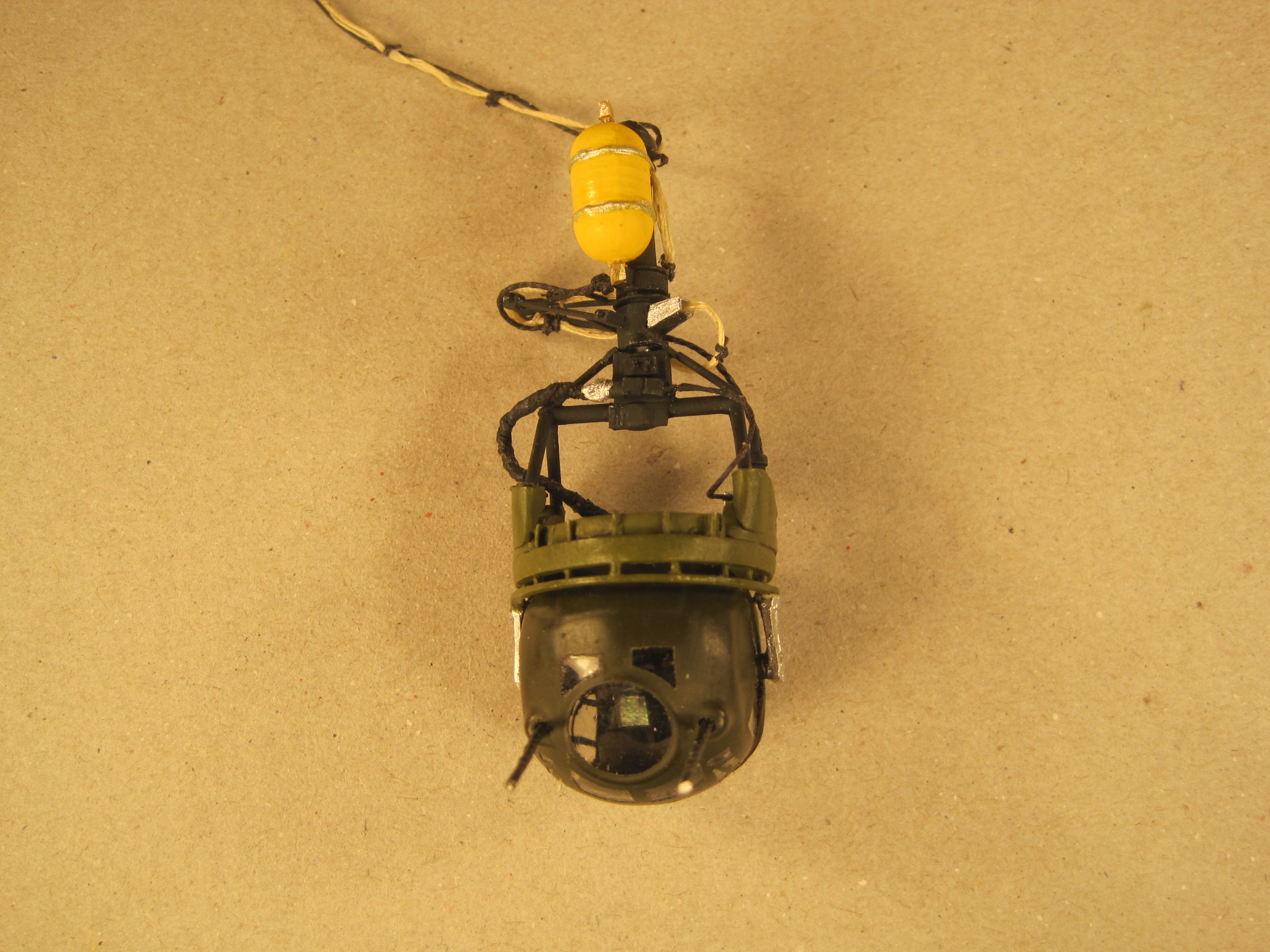

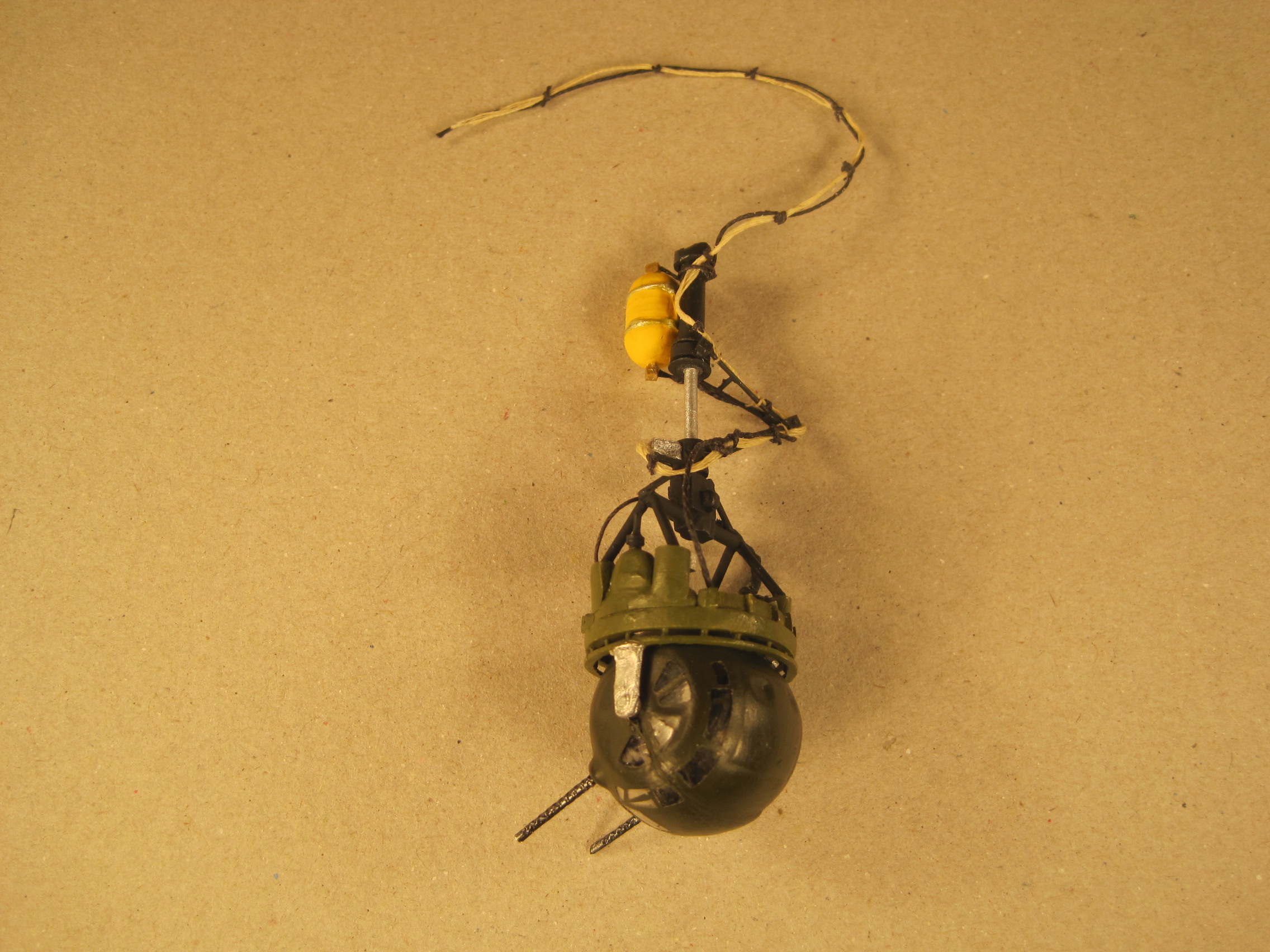
While I'm waiting to figure out what color to paint the interior and also to figure out the sequence in final assembly, I thought I'd start work on the Vector Resin engines. They are really beautiful, but I realized that if I used them as is, the props wouldn't turn as the prop shaft is molded in as part of the entire assembly. So I decided to modify them so the props would turn. There IS an easier way to do this, that is simply drill a hole through the center of the assembly and use a styrene rod with a cap on the back to hold it in place, but the original prop shafts are so well done (they have SPLINES for goodness sake!), so I devised a way to modify them so the props would turn and still keep the original prop shaft. Even though that will be buried inside the props when I'm done. Can't help myself. So here's what I did (times 4):
Here's a shot of the engine as is (haven't added the front 7 cylinders yet):
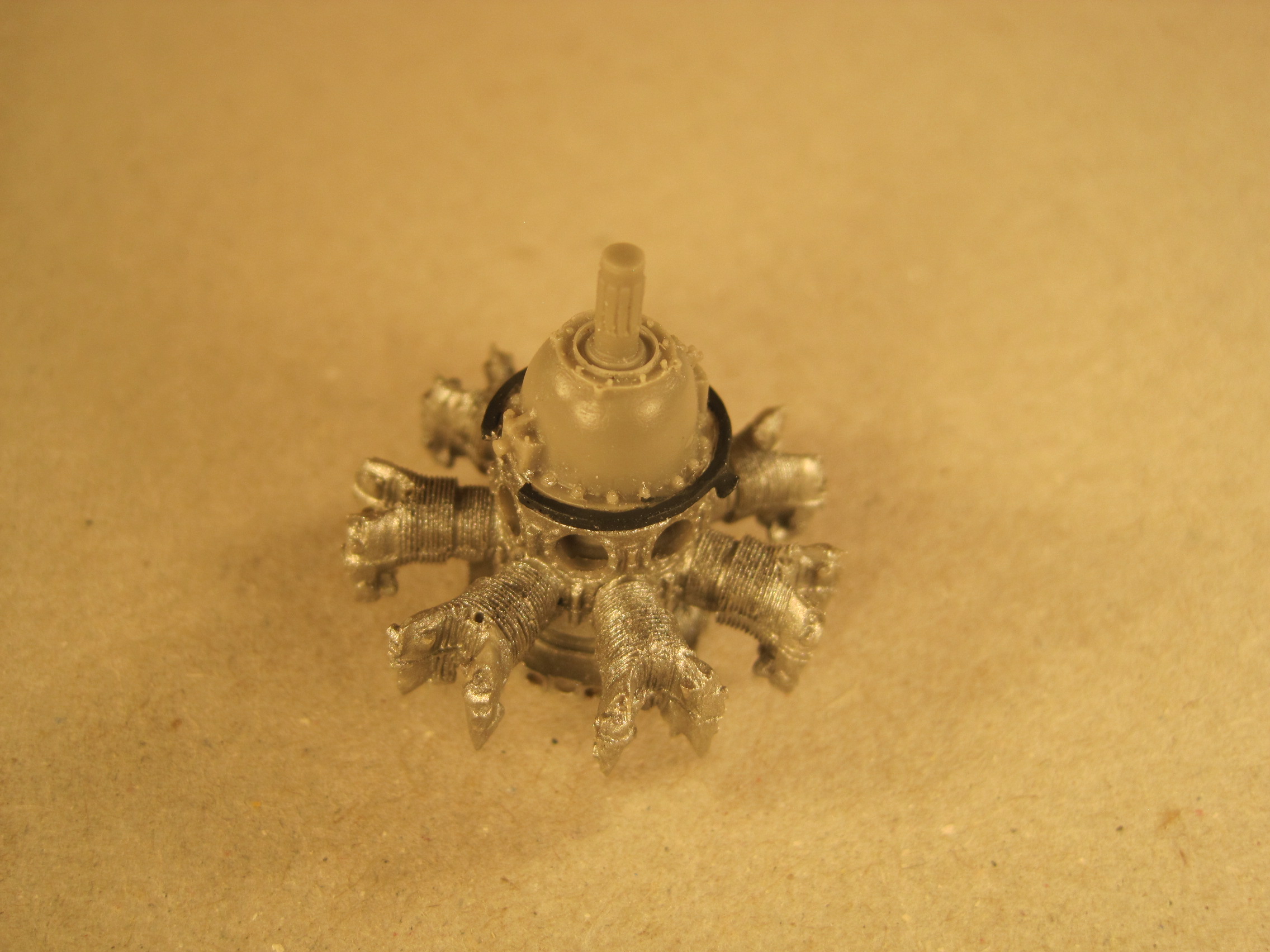
First step is to use a jeweler's coping saw and cut off the front attachment plate and prop shaft:
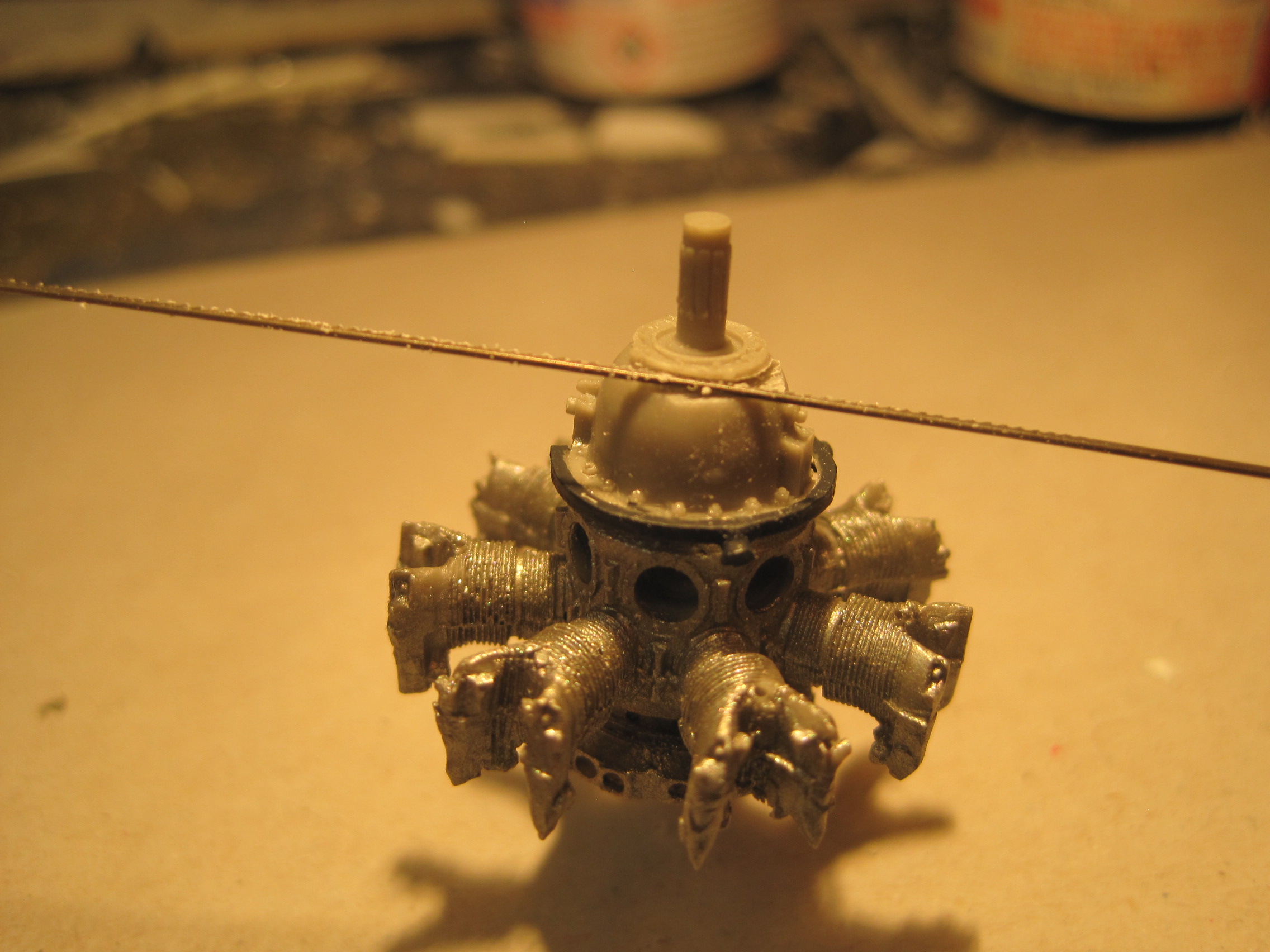
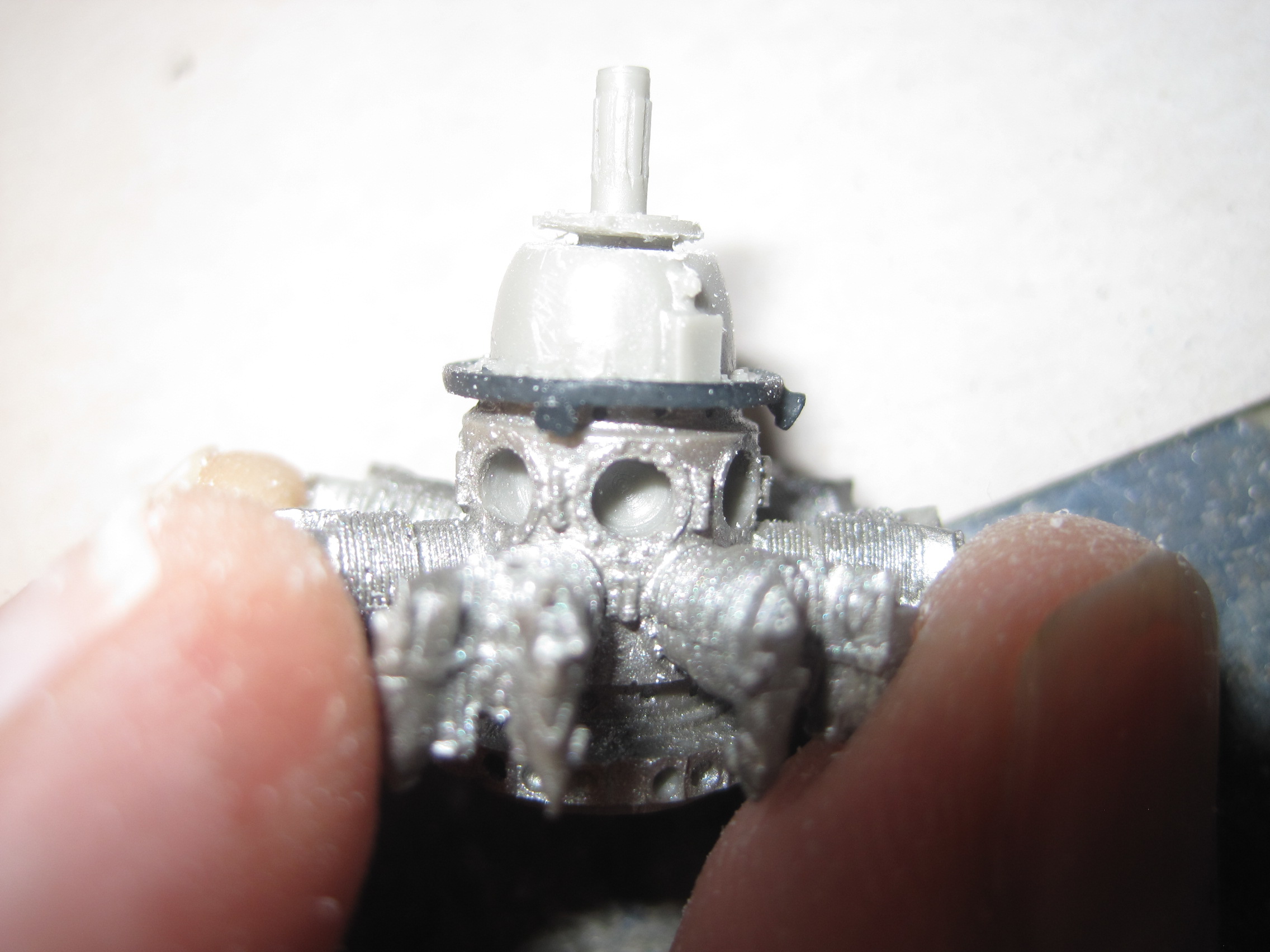
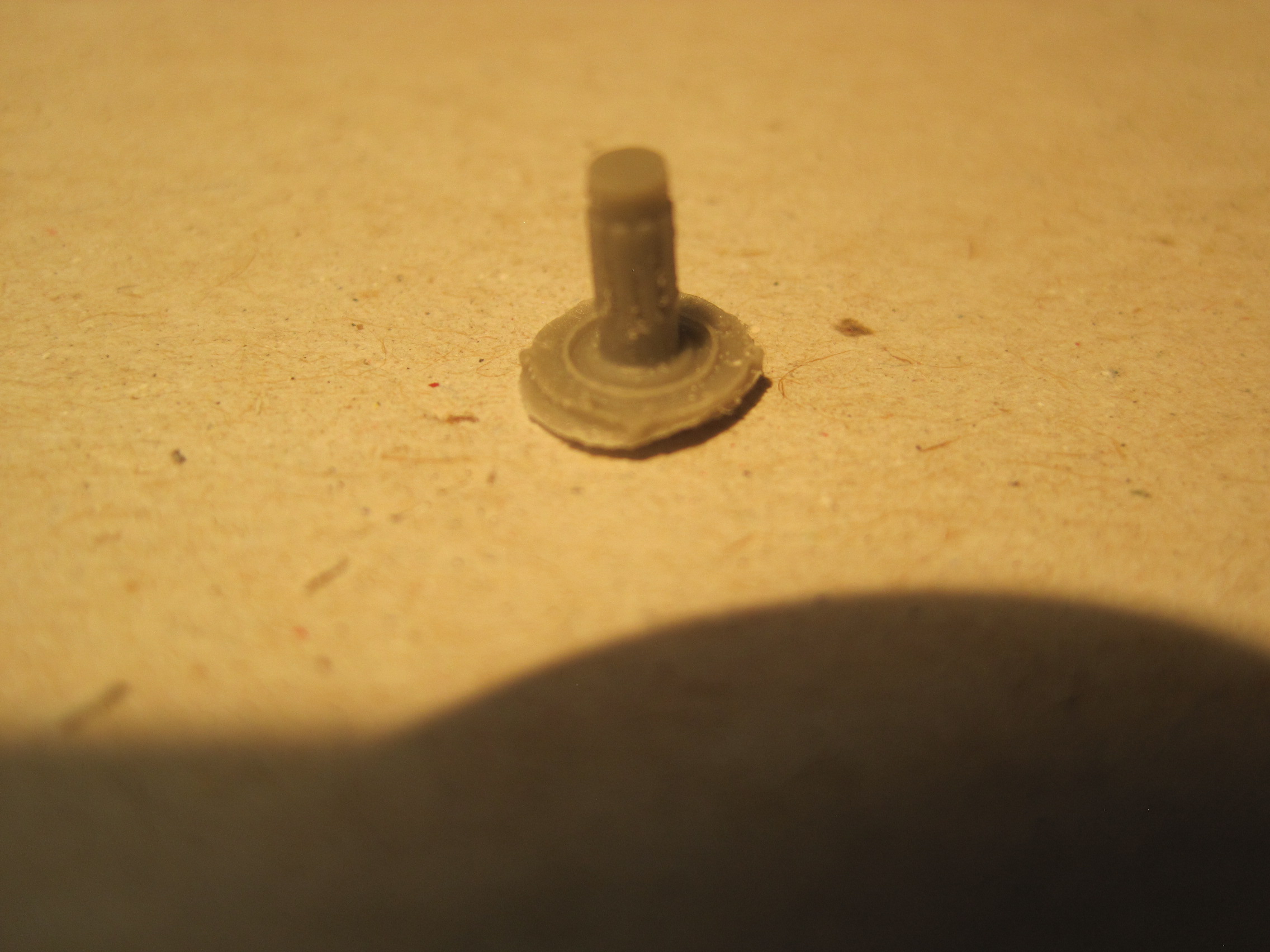
Next is one of the hardest parts. Using the very tip of the Exacto knife cut out the prop shaft from the mounting cover:
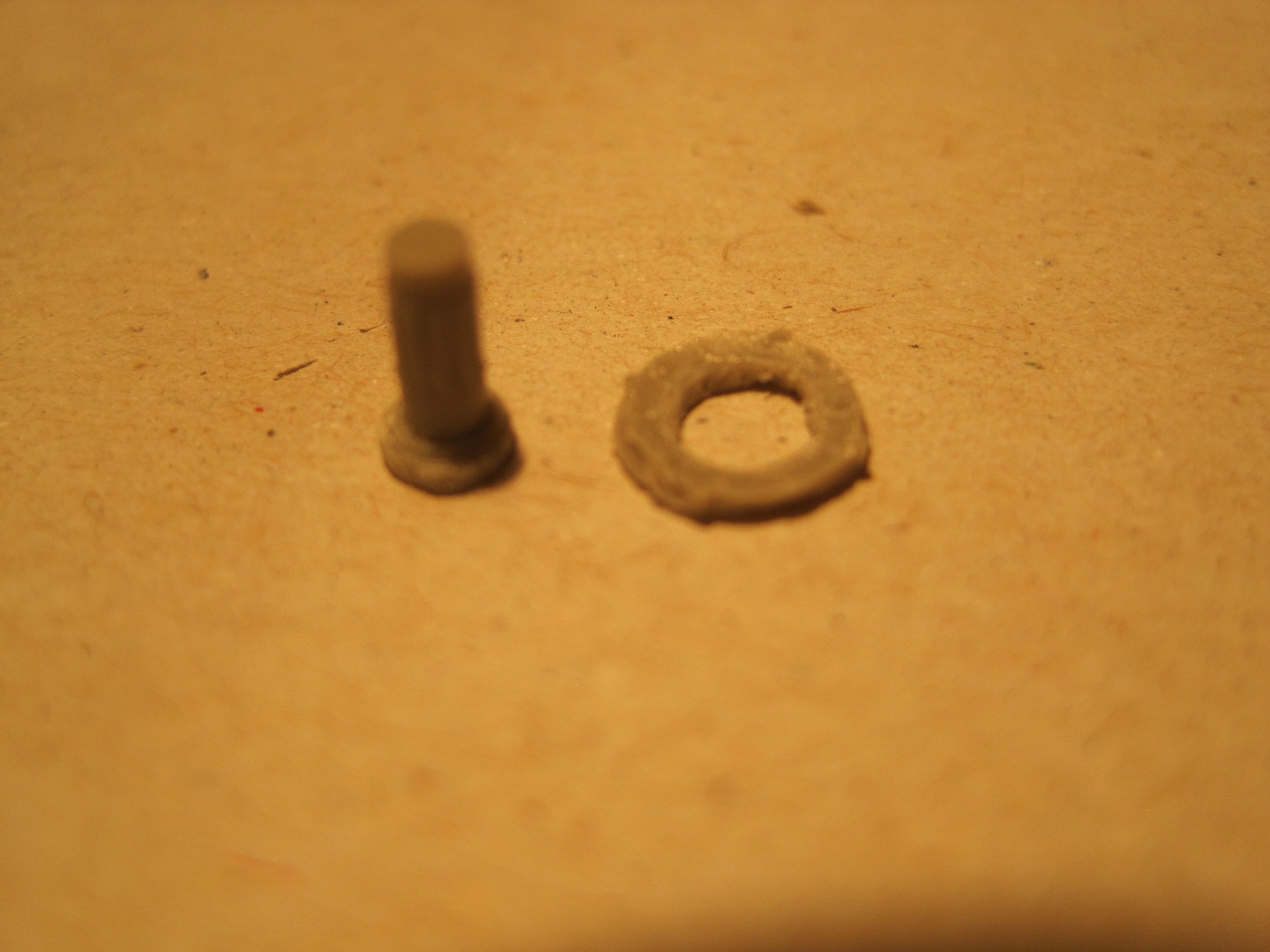
Next drill out the back end of the prop shaft so that you can inset a small rod which will help mount through what will be the cap into the rod which will be used as the full shaft:
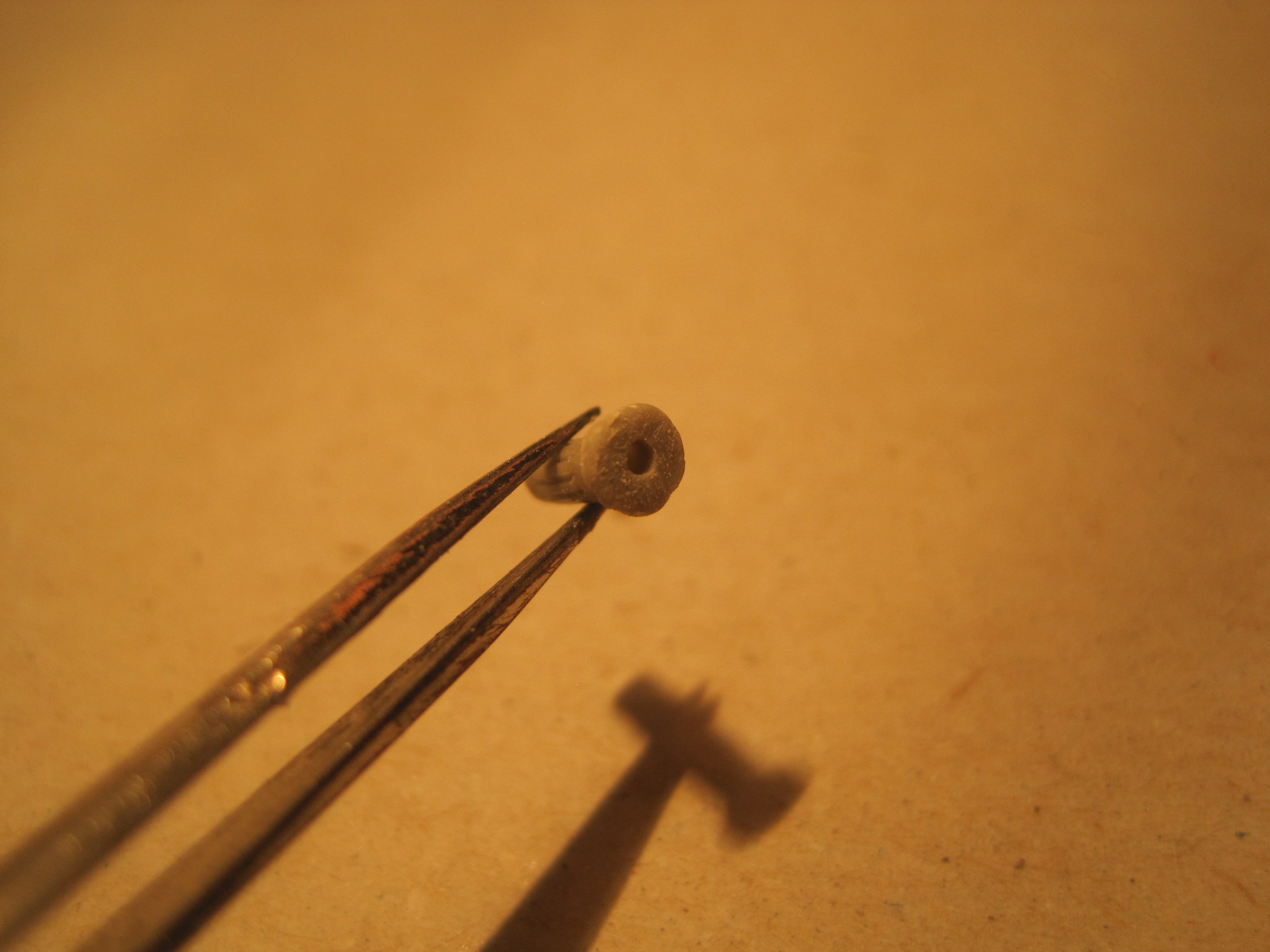
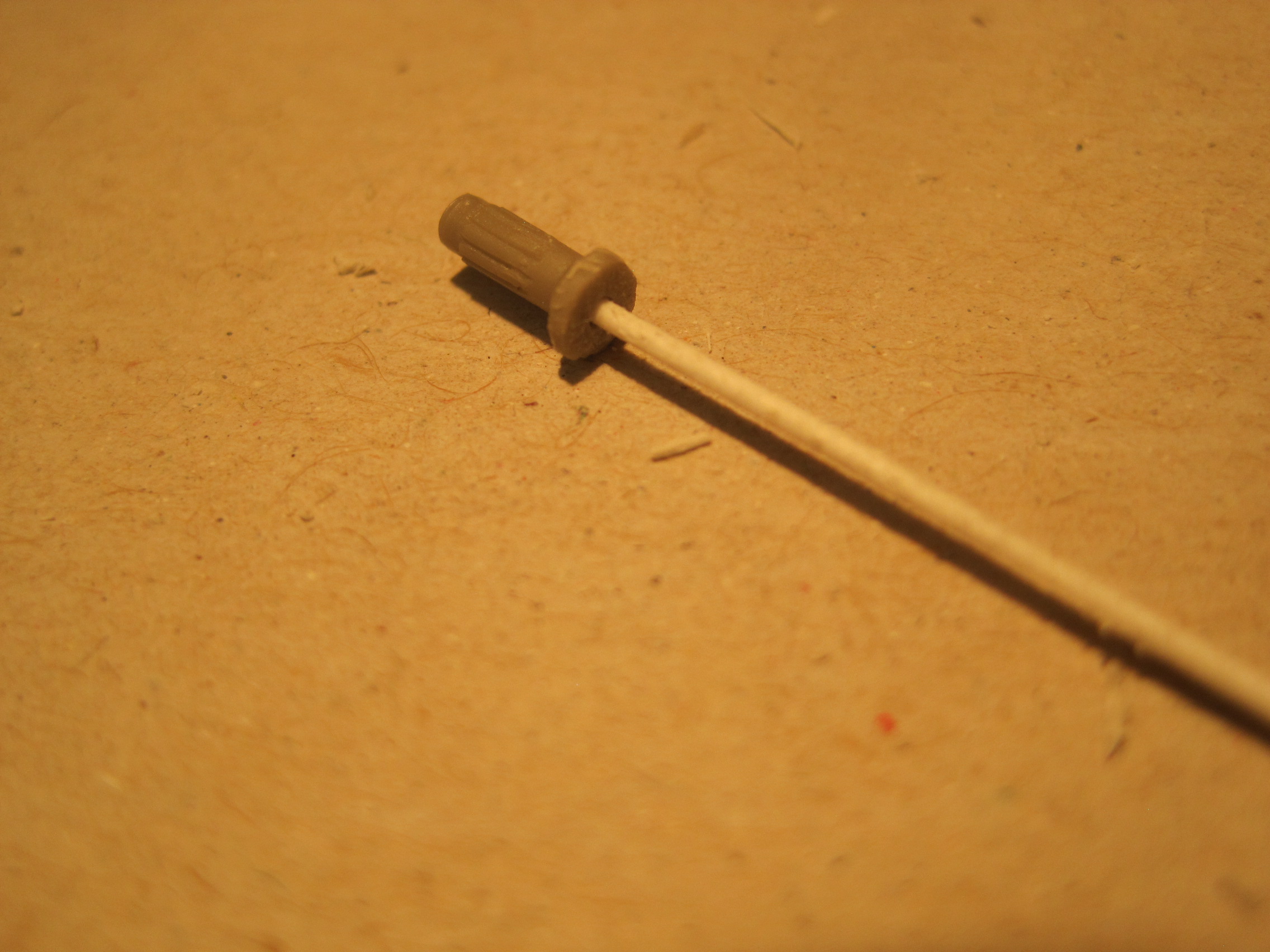
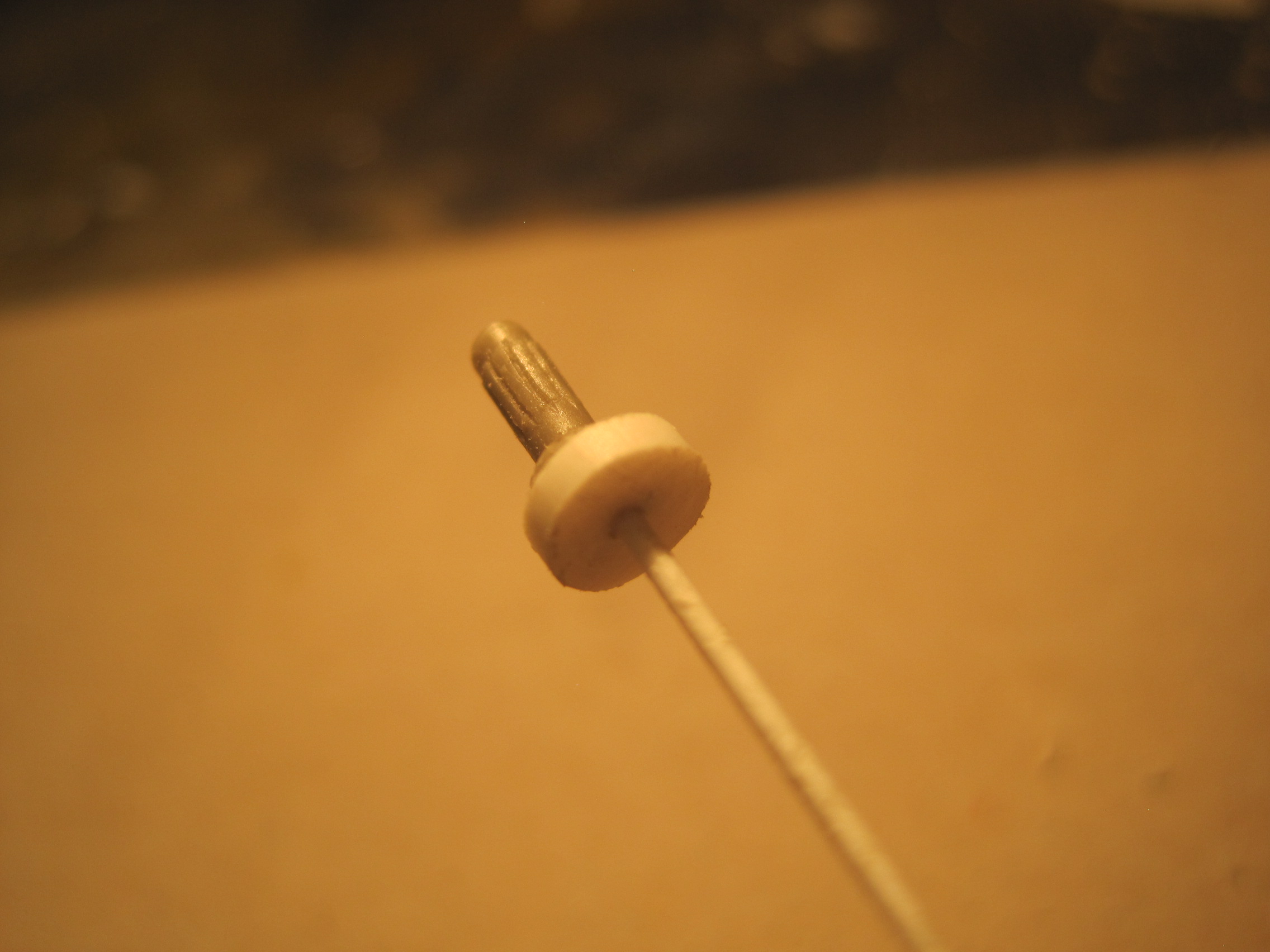
Next, after smoothing the recently cut front surface of the engine, start a small hole in the center. If you HAVE a drill press, that will help, but I just kept an eye to make sure it stayed "square" as I drilled. I also started a second hole in the back to minimize any error.
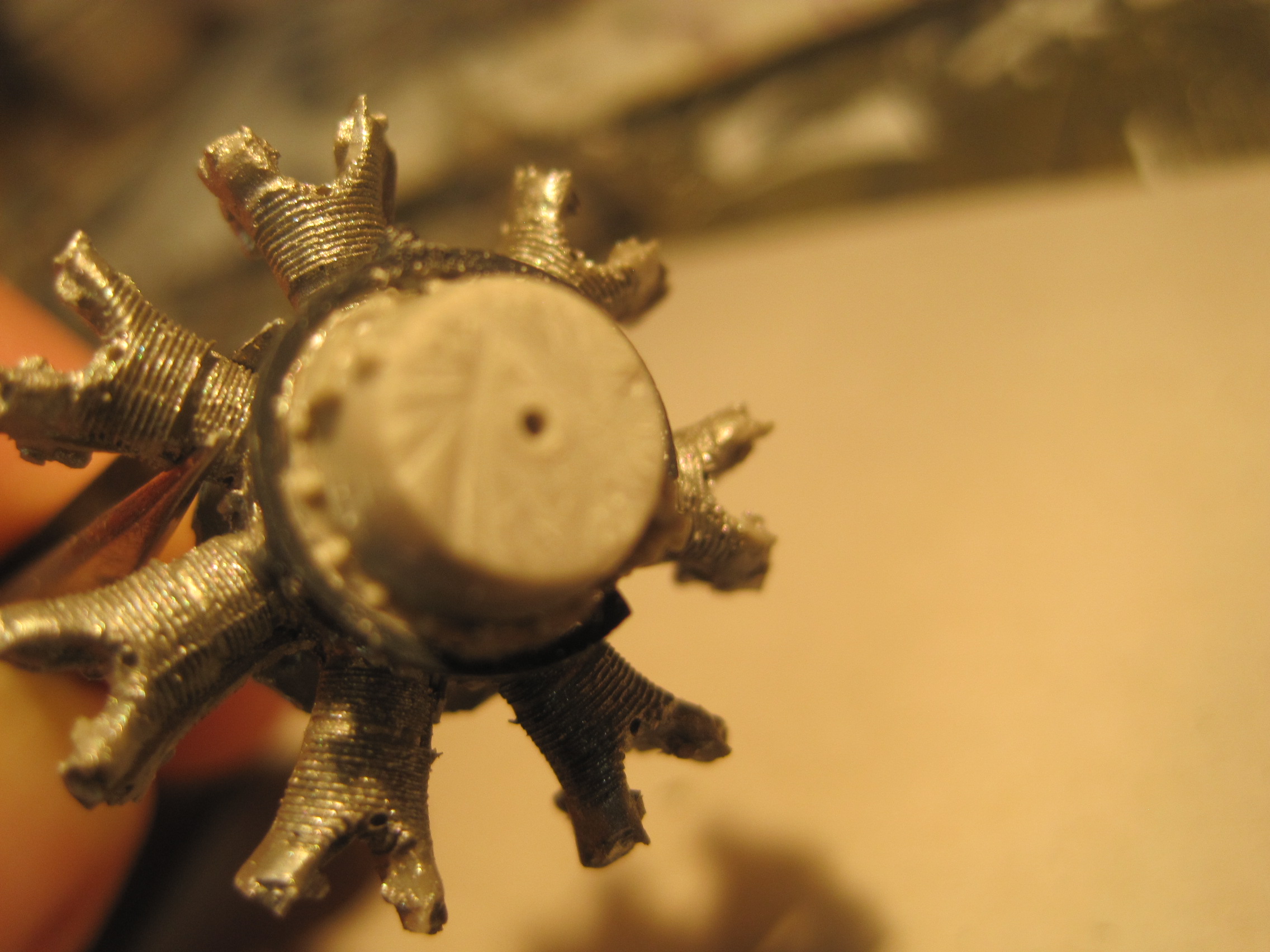

After you've finished the small pilot hole, use a couple of increasingly larger drill bits until the hole is large enough so your new shaft will spin.
The next step is to create a new cover plate to help hold in the new shaft:
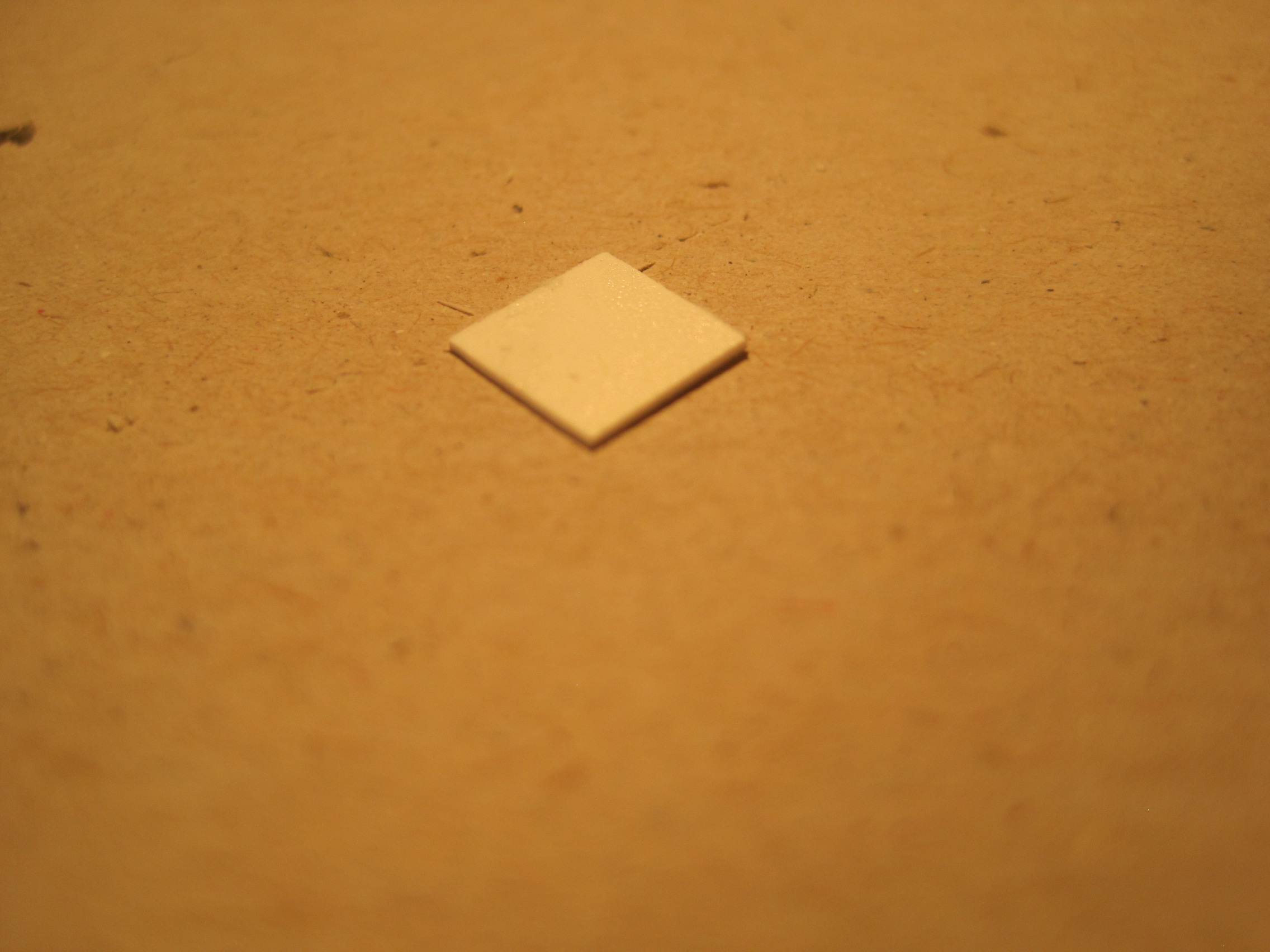

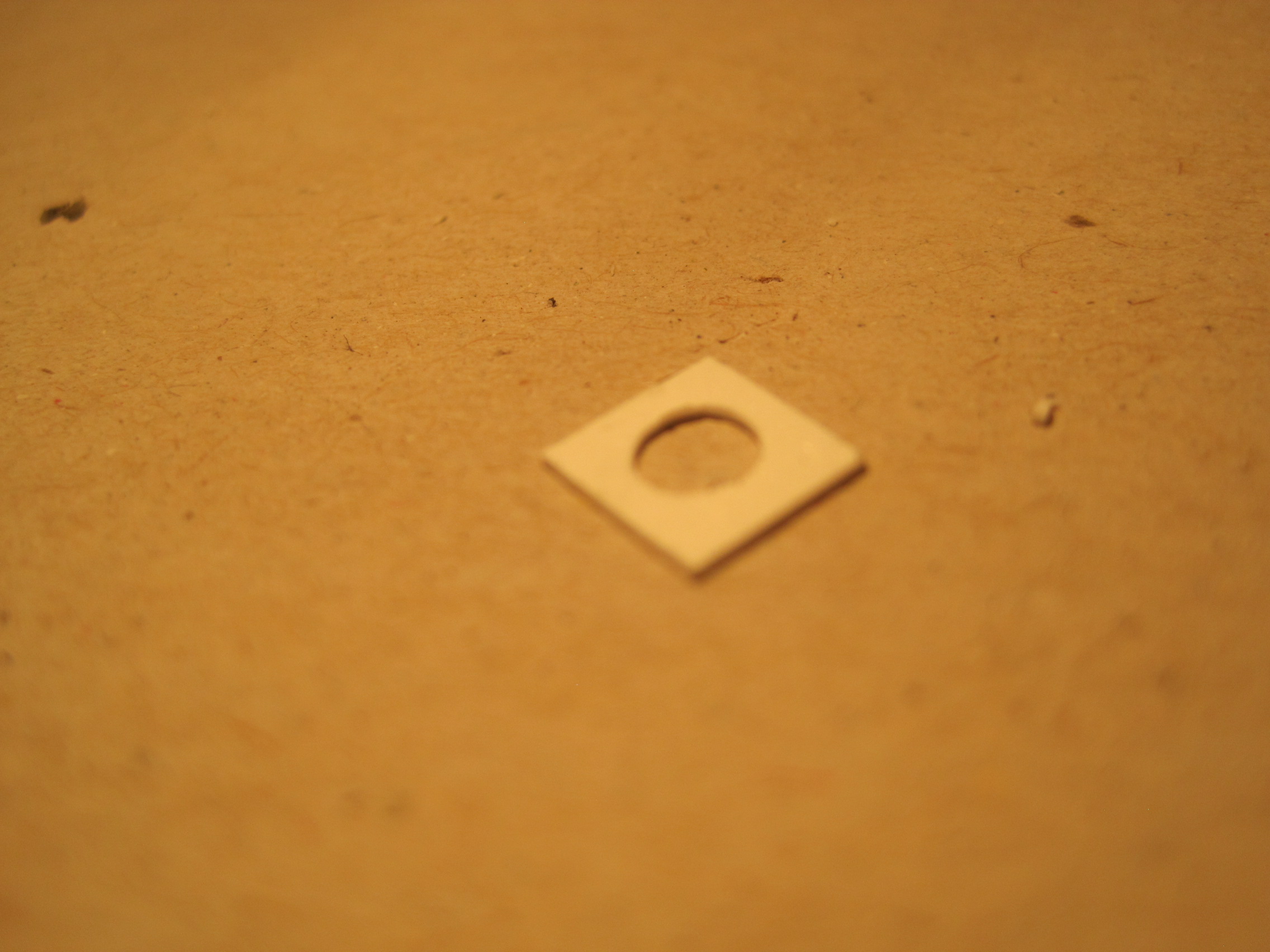

The next step requires a bit of patience. After you've put the back end of the shaft on to the larger cap and original prop shaft, drill out the front of the engine to the LARGER diameter of the "cap" but ONLY as deep as the THICKNESS of the cap. This allows the shaft to slip all the way through the hole you drilled but only until the larger cap hits the bottom of the larger hole and also allows the cap to spin and sit JUST BELOW the front surface of the engine. The parts should look like this:

After you drop the new shaft in, carefully glue the new cover plate to ONLY the front of the engine so the new shaft still spins:

And then finally take the original cover which you cut off and glue it over the scratch built cover:
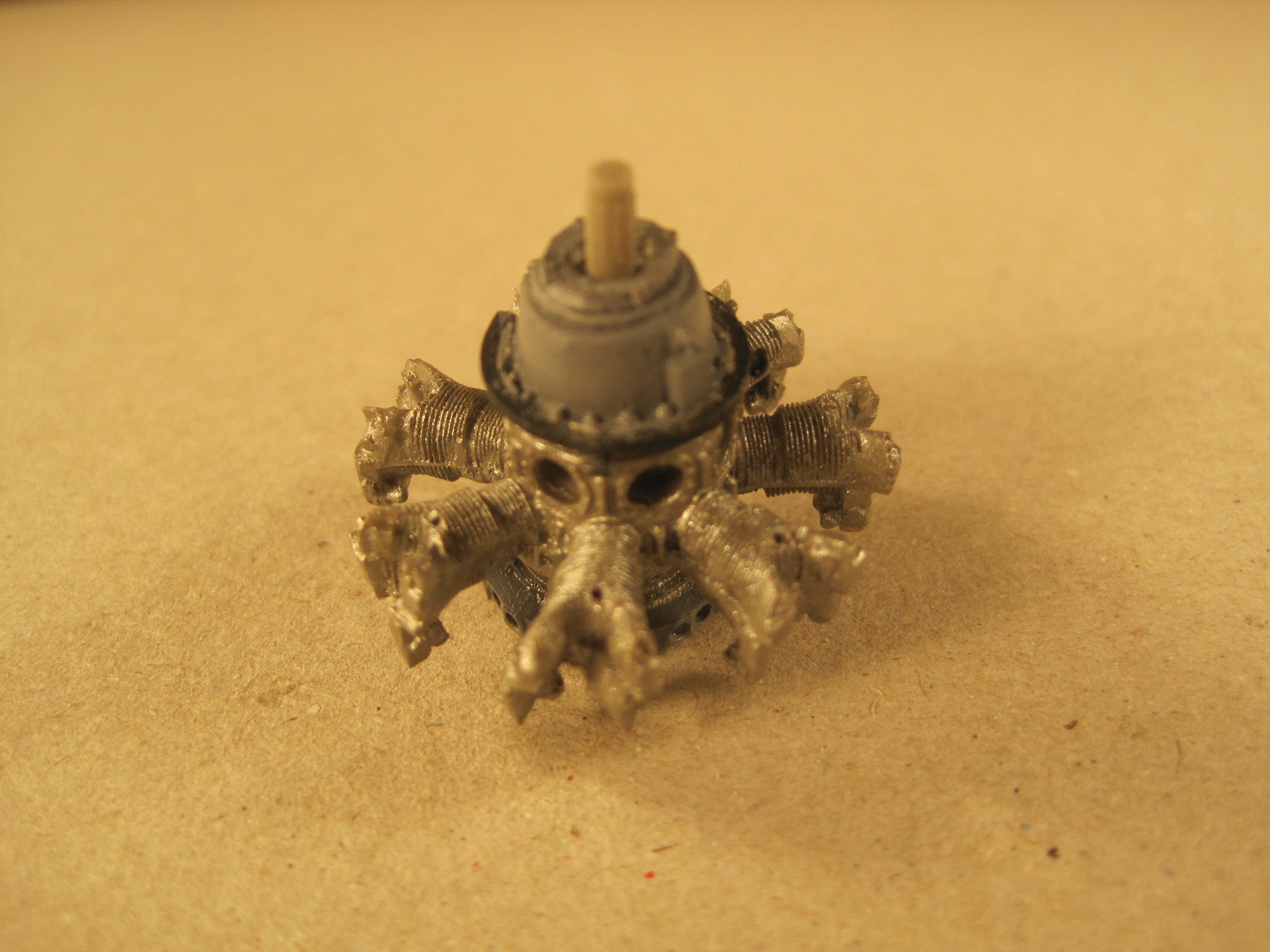
Lots of work, but I know I'll be glad to have props that spin.



While I'm waiting to figure out what color to paint the interior and also to figure out the sequence in final assembly, I thought I'd start work on the Vector Resin engines. They are really beautiful, but I realized that if I used them as is, the props wouldn't turn as the prop shaft is molded in as part of the entire assembly. So I decided to modify them so the props would turn. There IS an easier way to do this, that is simply drill a hole through the center of the assembly and use a styrene rod with a cap on the back to hold it in place, but the original prop shafts are so well done (they have SPLINES for goodness sake!), so I devised a way to modify them so the props would turn and still keep the original prop shaft. Even though that will be buried inside the props when I'm done. Can't help myself. So here's what I did (times 4):
Here's a shot of the engine as is (haven't added the front 7 cylinders yet):

First step is to use a jeweler's coping saw and cut off the front attachment plate and prop shaft:



Next is one of the hardest parts. Using the very tip of the Exacto knife cut out the prop shaft from the mounting cover:

Next drill out the back end of the prop shaft so that you can inset a small rod which will help mount through what will be the cap into the rod which will be used as the full shaft:



Next, after smoothing the recently cut front surface of the engine, start a small hole in the center. If you HAVE a drill press, that will help, but I just kept an eye to make sure it stayed "square" as I drilled. I also started a second hole in the back to minimize any error.


After you've finished the small pilot hole, use a couple of increasingly larger drill bits until the hole is large enough so your new shaft will spin.
The next step is to create a new cover plate to help hold in the new shaft:




The next step requires a bit of patience. After you've put the back end of the shaft on to the larger cap and original prop shaft, drill out the front of the engine to the LARGER diameter of the "cap" but ONLY as deep as the THICKNESS of the cap. This allows the shaft to slip all the way through the hole you drilled but only until the larger cap hits the bottom of the larger hole and also allows the cap to spin and sit JUST BELOW the front surface of the engine. The parts should look like this:

After you drop the new shaft in, carefully glue the new cover plate to ONLY the front of the engine so the new shaft still spins:

And then finally take the original cover which you cut off and glue it over the scratch built cover:

Lots of work, but I know I'll be glad to have props that spin.
thathaway3

Joined: September 10, 2004
KitMaker: 1,610 posts
AeroScale: 85 posts

Posted: Monday, May 01, 2017 - 03:49 AM UTC
Here's the latest update on the engines. The first shot shows the engine with the additional 7 cylinders added:
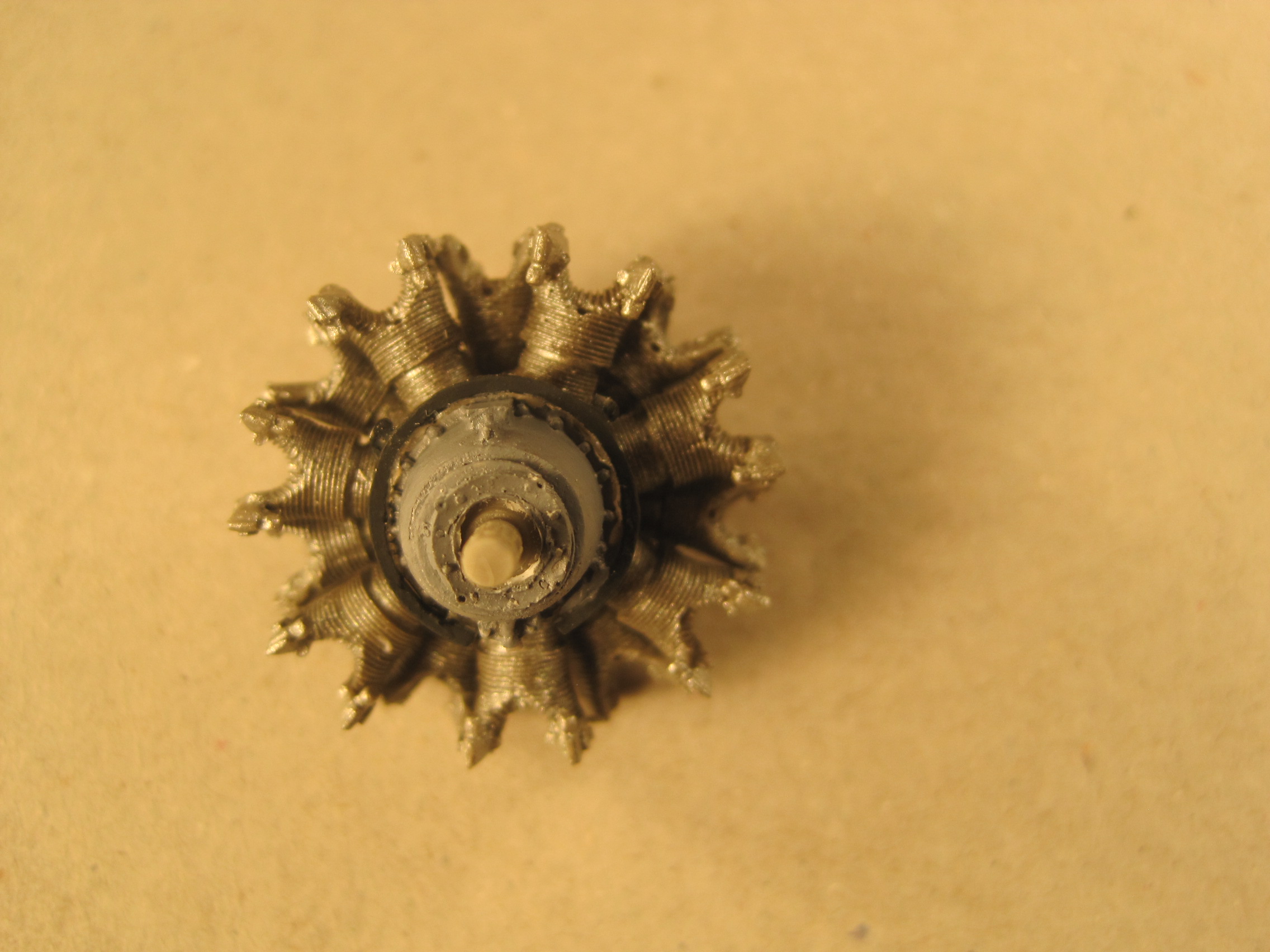
The next one shows the engine partially detailed:
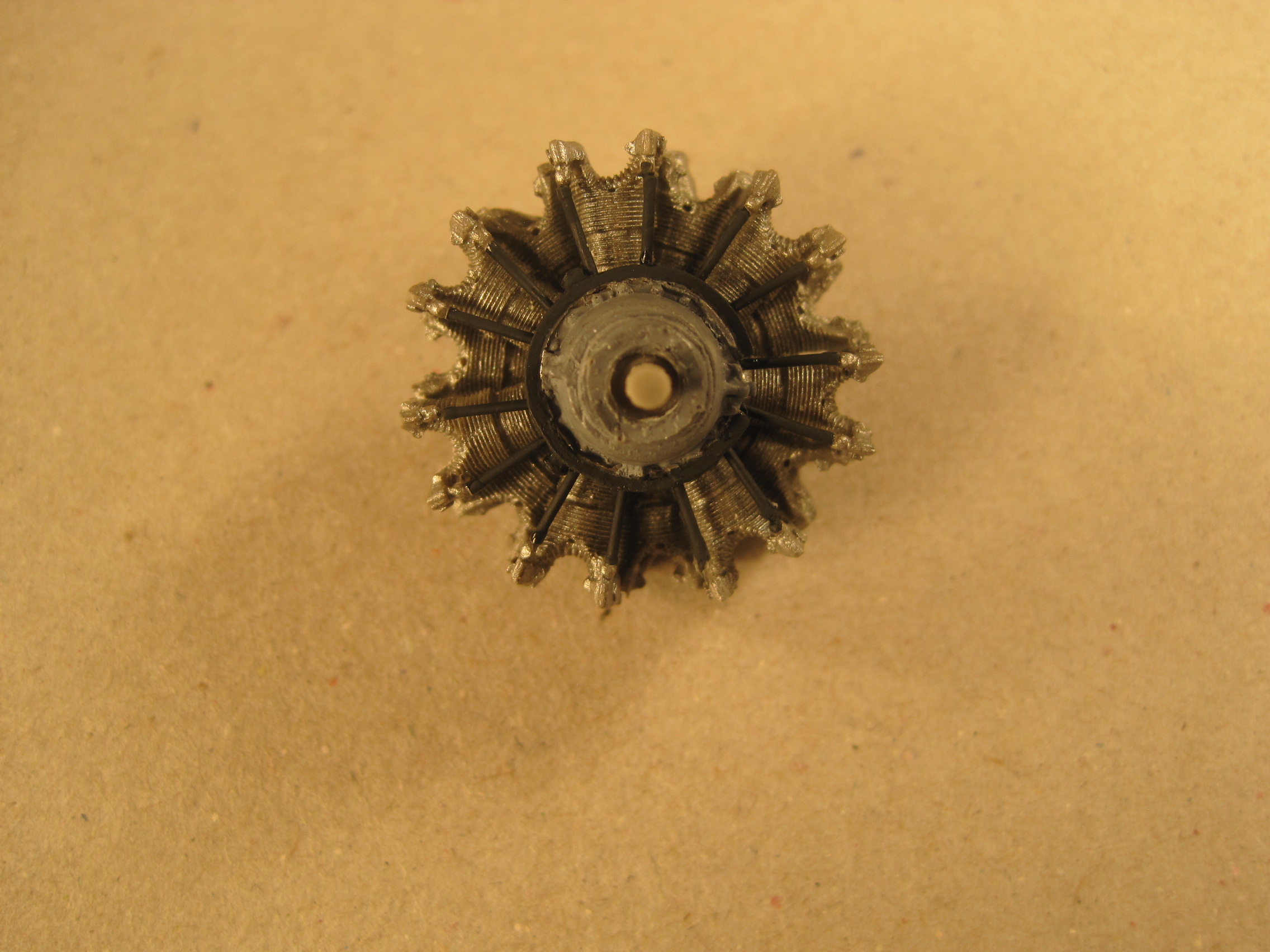
And this last shot shows the engine fully detailed. (Only three more to go! )
)
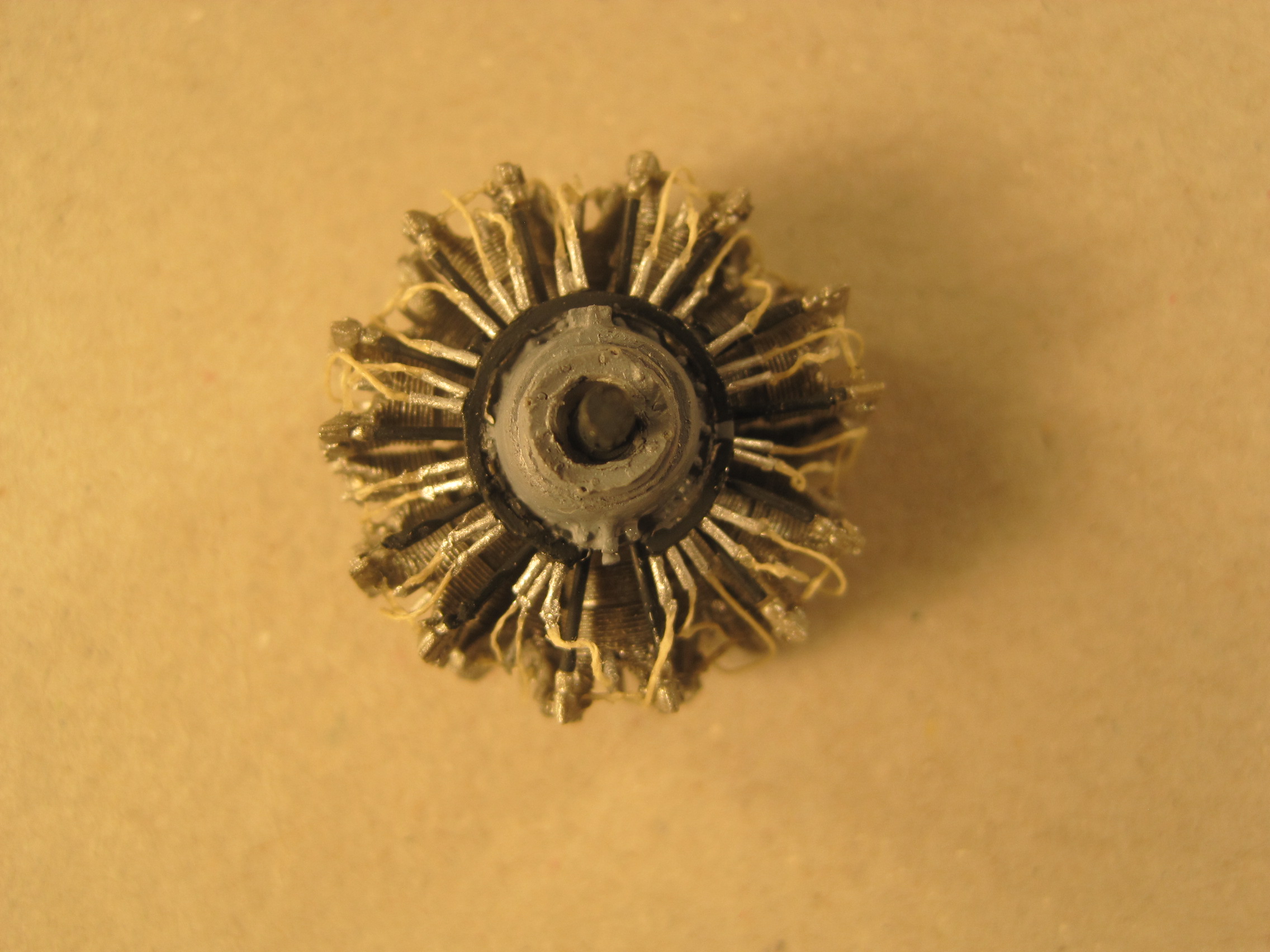
And here are the "before and after" of the upper and lower wing sections showing the modifications which have to be made to accommodate the aftermarket engines as well as the wheel well update set:
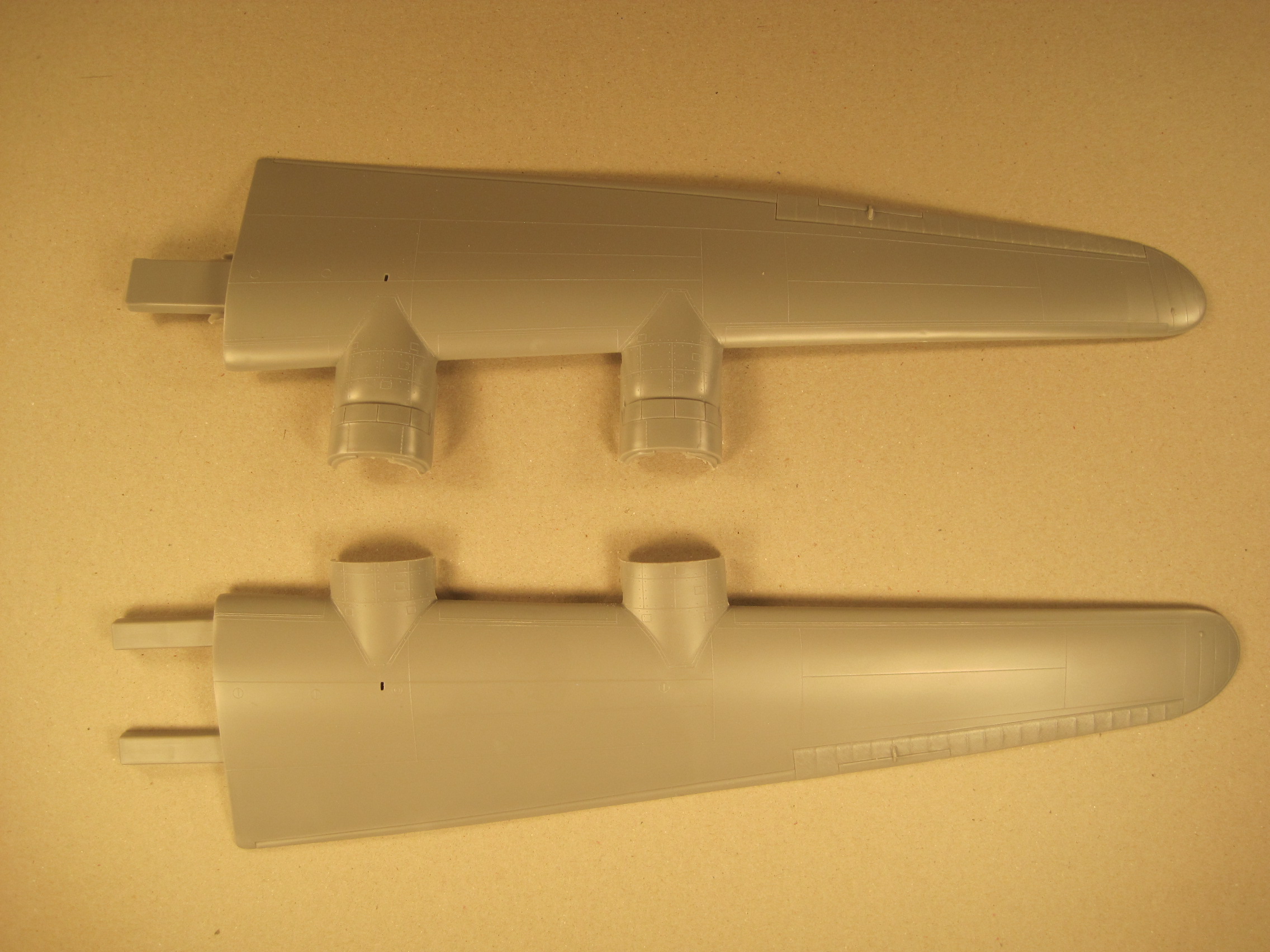

And finally a before and after of the fuselage side to show the modification to accommodate the enclosed waist gun window, and the removal of the wind block forward of the open window:


The next one shows the engine partially detailed:

And this last shot shows the engine fully detailed. (Only three more to go!
 )
)
And here are the "before and after" of the upper and lower wing sections showing the modifications which have to be made to accommodate the aftermarket engines as well as the wheel well update set:


And finally a before and after of the fuselage side to show the modification to accommodate the enclosed waist gun window, and the removal of the wind block forward of the open window:

rochaped

Joined: August 27, 2010
KitMaker: 679 posts
AeroScale: 669 posts
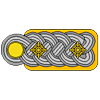
Posted: Monday, May 01, 2017 - 05:12 AM UTC
Tom,
Splendid work so far. Your detailing goal is certainly very high but so far the results are mind blowing...those turrets are true gems, seem like 1/32 work.
Keep it up
Cheers
Pedro
Splendid work so far. Your detailing goal is certainly very high but so far the results are mind blowing...those turrets are true gems, seem like 1/32 work.
Keep it up
Cheers
Pedro
thathaway3

Joined: September 10, 2004
KitMaker: 1,610 posts
AeroScale: 85 posts

Posted: Thursday, May 25, 2017 - 06:09 AM UTC
Update time. I decided to add the wiring for the spark plugs to the engines. Two per cylinder. Fourteen cylinders per engine. Four engines.
And of course the length of the wire is different for the front plug for each cylinder than the one that goes to the back, and of course the two lengths for the front bank of cylinders is different from the rear bank of cylinders.
Anyway the first photo shows MOST of the wires laid out for THREE engines. I had already done one when I decided that fabricating all the pieces first and then doing all the assembly was more efficient. (You'd think that after spending 30 years as an automobile design engineer, I'd have remembered that!)
So I did the bottom front cylinder for the remaining three engines first since it was different, and then laid out all the rest.
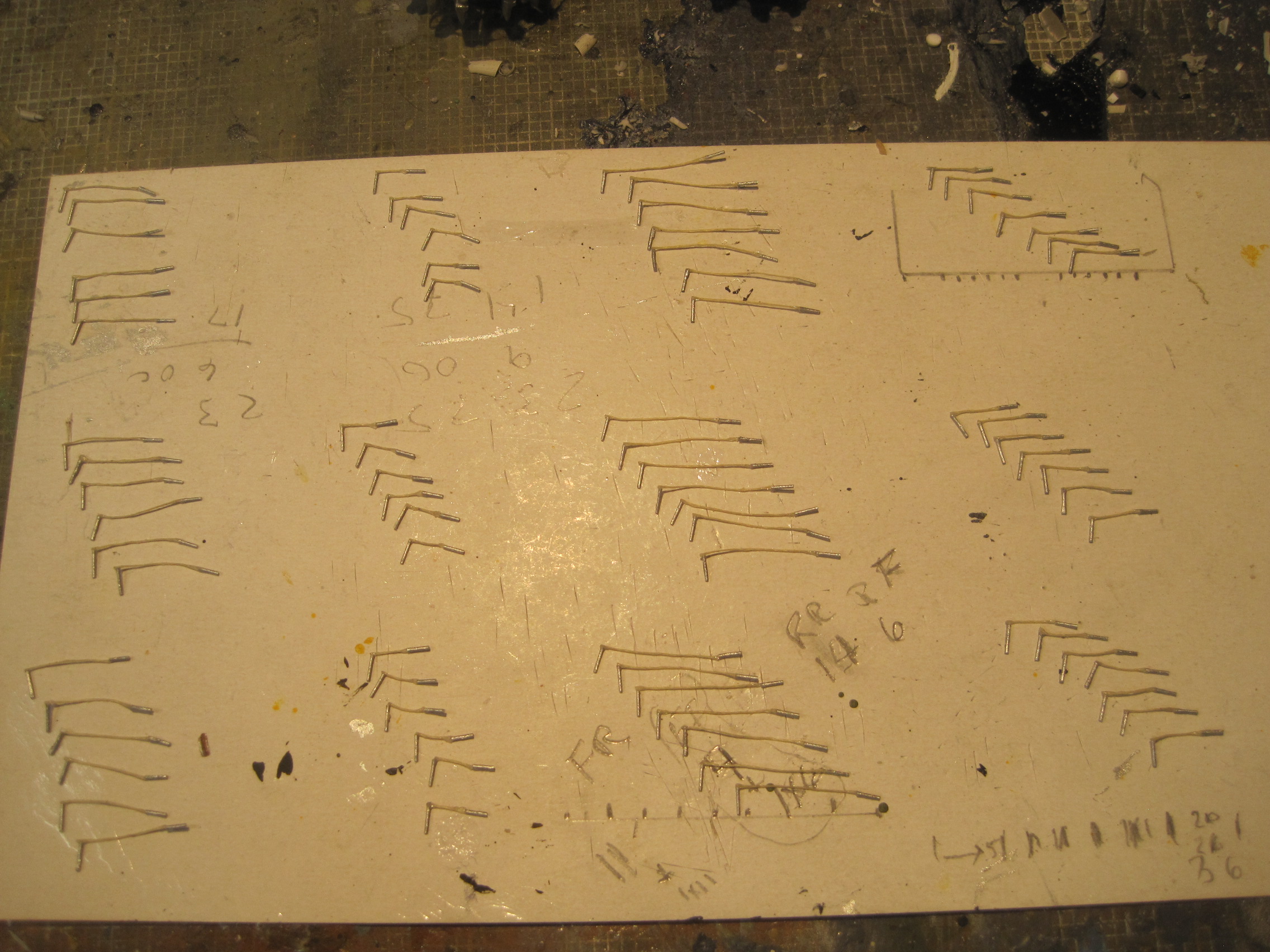
And here are all four engines complete.
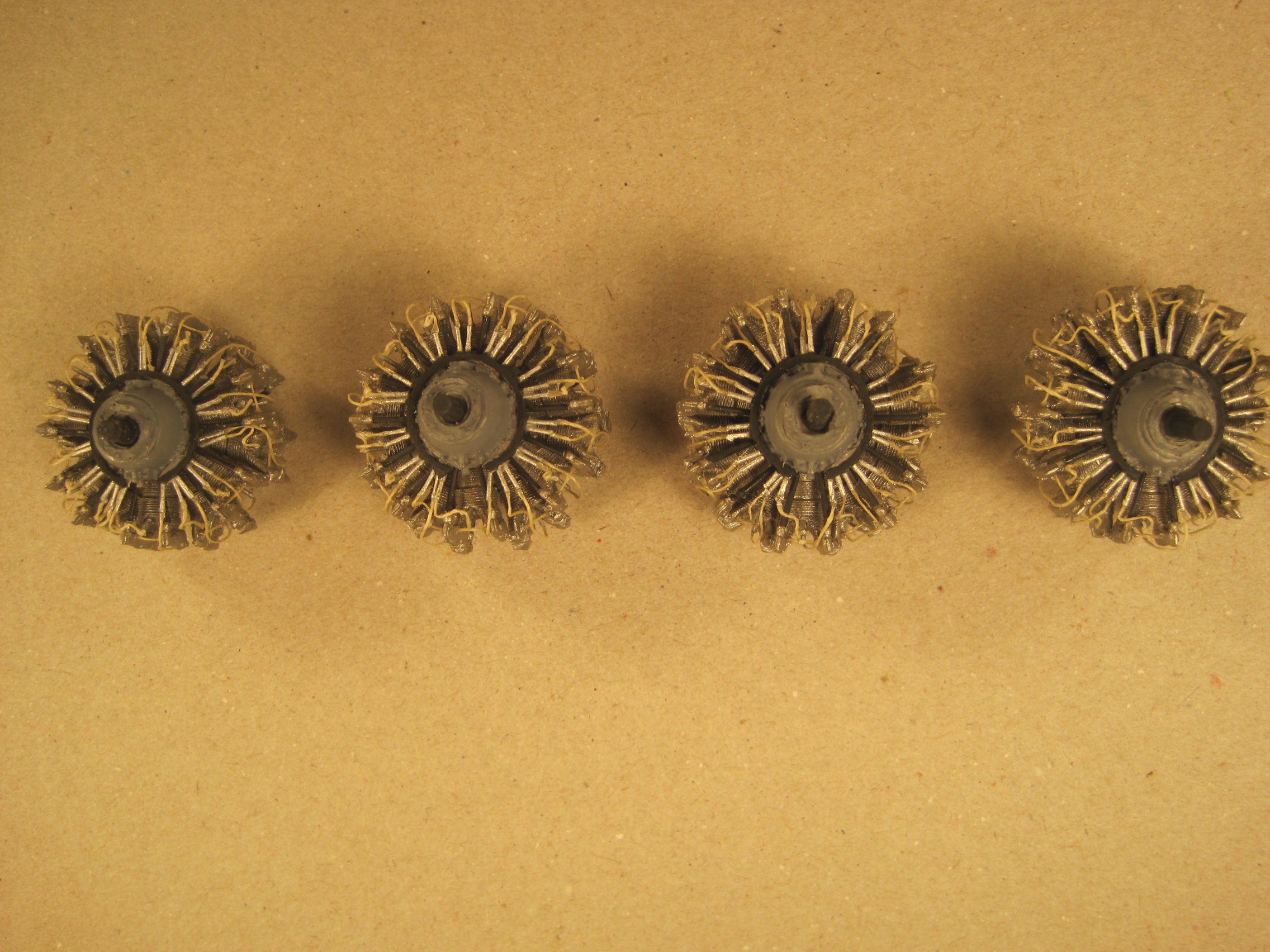
So here's a question for the group:
Has anybody attempted to separate the main flaps from the wings? They are molded into the wings and this results in a significant part of the upper surface of the flaps to be basically non-existent as it is "hidden" inside the wing structure when the flaps are up. The ailerons don't seem to be TOO hard at least after a preliminary look, although the trim tabs could be "interesting".
Any good photos or suggestions?
And of course the length of the wire is different for the front plug for each cylinder than the one that goes to the back, and of course the two lengths for the front bank of cylinders is different from the rear bank of cylinders.
Anyway the first photo shows MOST of the wires laid out for THREE engines. I had already done one when I decided that fabricating all the pieces first and then doing all the assembly was more efficient. (You'd think that after spending 30 years as an automobile design engineer, I'd have remembered that!)
So I did the bottom front cylinder for the remaining three engines first since it was different, and then laid out all the rest.

And here are all four engines complete.

So here's a question for the group:
Has anybody attempted to separate the main flaps from the wings? They are molded into the wings and this results in a significant part of the upper surface of the flaps to be basically non-existent as it is "hidden" inside the wing structure when the flaps are up. The ailerons don't seem to be TOO hard at least after a preliminary look, although the trim tabs could be "interesting".
Any good photos or suggestions?

KPHB17FE

Joined: January 12, 2015
KitMaker: 292 posts
AeroScale: 292 posts

Posted: Thursday, May 25, 2017 - 09:58 PM UTC
thathaway3

Joined: September 10, 2004
KitMaker: 1,610 posts
AeroScale: 85 posts

Posted: Thursday, May 25, 2017 - 10:09 PM UTC
Thanks, that's very helpful. The most difficult and tedious part seems to be all the ribbing/spar structure on the inside. Given that the flaps are generally up while on the ground, what I may do is cut the flaps out to separate them from the wing, but then "re-install" them in the up position. That way hopefully they'll "look" better than just being molded in.
Maybe!
Maybe!
thathaway3

Joined: September 10, 2004
KitMaker: 1,610 posts
AeroScale: 85 posts

Posted: Monday, June 05, 2017 - 01:49 AM UTC
Does anybody have some decent photos of the rear crew exterior entry hatch and the retracting tail skid?
Since I'm using the Eduard Interior floor for the waist gunner's compartment, there is now nothing to attach the tails skid to, and quite frankly what the kit provides as an attachment method leaves a bit to be desired.
I've got a rough idea of how to modify the skid so that it will attach better, but I have not been able to determine how the hatch is attached/secured. Is it hinged and if so where?
Since I'm using the Eduard Interior floor for the waist gunner's compartment, there is now nothing to attach the tails skid to, and quite frankly what the kit provides as an attachment method leaves a bit to be desired.
I've got a rough idea of how to modify the skid so that it will attach better, but I have not been able to determine how the hatch is attached/secured. Is it hinged and if so where?
thathaway3

Joined: September 10, 2004
KitMaker: 1,610 posts
AeroScale: 85 posts

Posted: Tuesday, July 04, 2017 - 07:05 PM UTC
Well it appears as if Photo Bucket has eliminated the ability to post pictures to a 3rd Party site unless you pay $400 dollars PER year.
Not gonna happen.
At this point I haven't decided on my next step.
Not gonna happen.
At this point I haven't decided on my next step.

Scrodes

Joined: July 22, 2012
KitMaker: 771 posts
AeroScale: 763 posts

Posted: Tuesday, July 04, 2017 - 10:40 PM UTC
imgur.com is the way to go.
thathaway3

Joined: September 10, 2004
KitMaker: 1,610 posts
AeroScale: 85 posts

Posted: Wednesday, July 05, 2017 - 05:59 AM UTC
I tried uploading some of the images to Imagur and it seems to be very difficult to arrange the images or identify them by file number.

sinistervampire319

Joined: May 07, 2009
KitMaker: 189 posts
AeroScale: 73 posts

Posted: Wednesday, July 05, 2017 - 07:08 AM UTC
Try Flickr.
thathaway3

Joined: September 10, 2004
KitMaker: 1,610 posts
AeroScale: 85 posts

Posted: Wednesday, July 05, 2017 - 08:52 PM UTC
Much better. Now the question is can you go back to previous posts and replace the old links with new ones, or perhaps even more to the point is it worth the time?
I highly doubt that I'll be interested in going back and doing that, as there are simply too many posts and images to correct.
So we'll just all be reminded that PB pulled the rug out from under our feet.
I highly doubt that I'll be interested in going back and doing that, as there are simply too many posts and images to correct.
So we'll just all be reminded that PB pulled the rug out from under our feet.
jjcadenhead

Joined: November 02, 2010
KitMaker: 32 posts
AeroScale: 3 posts

Posted: Thursday, July 06, 2017 - 12:03 AM UTC
The media is starting to report the change that Photobucket has made. I'm sure Photobucket will start to feel the pressure soon.
thathaway3

Joined: September 10, 2004
KitMaker: 1,610 posts
AeroScale: 85 posts

Posted: Thursday, July 06, 2017 - 09:05 PM UTC
Yeah, but will they change their policy? I wonder how much of a downside there is for them? They certainly don't "lose" anything if I cancel my account, since they get no revenue from me (unless they sell ads, which I've not noticed, so that shows how effective that'd be!). So if 99% of the people with free accounts cancel and 1% pay the $399 per year, they're money ahead.
No such thing as a free lunch, even with the internet!
No such thing as a free lunch, even with the internet!
Removed by original poster on 07/14/17 - 18:46:35 (GMT).
Removed by original poster on 07/14/17 - 18:48:48 (GMT).
 |




